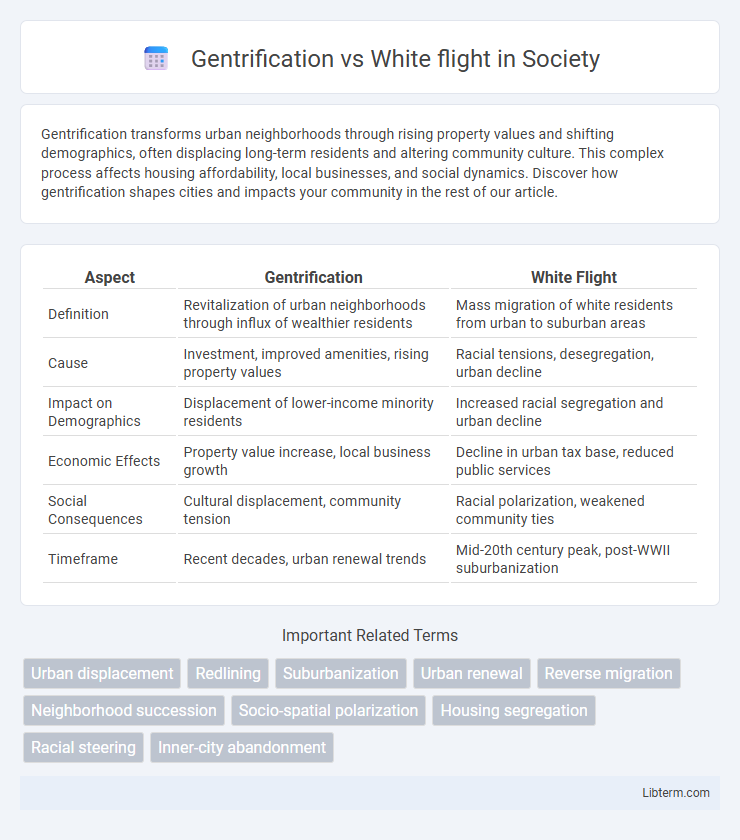Gentrification transforms urban neighborhoods through rising property values and shifting demographics, often displacing long-term residents and altering community culture. This complex process affects housing affordability, local businesses, and social dynamics. Discover how gentrification shapes cities and impacts your community in the rest of our article.
Table of Comparison
| Aspect | Gentrification | White Flight |
|---|---|---|
| Definition | Revitalization of urban neighborhoods through influx of wealthier residents | Mass migration of white residents from urban to suburban areas |
| Cause | Investment, improved amenities, rising property values | Racial tensions, desegregation, urban decline |
| Impact on Demographics | Displacement of lower-income minority residents | Increased racial segregation and urban decline |
| Economic Effects | Property value increase, local business growth | Decline in urban tax base, reduced public services |
| Social Consequences | Cultural displacement, community tension | Racial polarization, weakened community ties |
| Timeframe | Recent decades, urban renewal trends | Mid-20th century peak, post-WWII suburbanization |
Understanding Gentrification: Causes and Effects
Gentrification occurs when investments in urban neighborhoods lead to increased property values and the displacement of lower-income residents, often triggering demographic shifts. This process is driven by factors such as rising housing demand, economic development policies, and the influx of higher-income households seeking improved amenities. Effects include altered community composition, loss of affordable housing, and cultural displacement, which can contrast with white flight, where predominantly white residents leave neighborhoods in response to racial integration or economic changes.
Defining White Flight: Historical Context and Dynamics
White flight refers to the mass migration of white populations from urban centers to suburban areas, primarily occurring in the mid-20th century United States amidst racial desegregation and rising minority populations. This demographic shift was driven by factors such as perceived declines in urban living conditions, fears of declining property values, and desires for racially homogenous communities supported by discriminatory housing policies. Understanding white flight involves analyzing its impact on urban decay, socio-economic segregation, and the contrasting processes of gentrification shaping modern cities.
Demographic Shifts in Urban Neighborhoods
Gentrification drives demographic shifts by attracting higher-income, often white, residents to urban neighborhoods, displacing long-standing, predominantly minority communities. White flight occurs when white residents move out of these areas in response to increasing racial or economic diversity, accelerating suburbanization and altering urban demographics. Both phenomena significantly reshape the socioeconomic and racial composition of cities, influencing housing markets, local economies, and community identities.
Economic Drivers Behind Gentrification and White Flight
Economic drivers behind gentrification include increased property values and investment in urban neighborhoods, attracting higher-income residents and businesses, which often displaces long-standing, lower-income communities. Conversely, white flight is driven by economic factors such as declining property values, rising crime rates, and perceived threats to social status, prompting middle-class white families to relocate to suburban areas. The disparity in economic incentives creates a cycle where gentrification revitalizes city centers while white flight accelerates suburban growth and urban divestment.
Racial and Cultural Impacts on Communities
Gentrification often leads to the displacement of long-standing minority communities as rising property values and living costs favor wealthier, predominantly white newcomers, eroding cultural heritage and social networks. Conversely, white flight involves the mass relocation of white residents from urban areas experiencing increased racial diversity, which exacerbates economic decline and reinforces segregation. Both phenomena reshape community demographics, intensify racial tensions, and alter cultural landscapes, influencing access to resources, political representation, and neighborhood identity.
Housing Market Transformations: Winners and Losers
Gentrification often drives up property values and rents, benefiting property owners and investors while displacing lower-income residents, predominantly minorities. White flight occurs when white residents relocate from urban centers to suburbs, leading to decreased property values and investment in affected neighborhoods. These opposing movements reshape housing markets, creating winners among wealthier newcomers and property owners, and losers among vulnerable communities facing affordability loss and social displacement.
Comparing Consequences: Displacement vs. Abandonment
Gentrification often results in displacement as rising property values and living costs push out long-term, lower-income residents, altering neighborhood demographics and cultural fabric. White flight leads to abandonment, where predominantly white residents leave declining urban areas, causing economic deterioration, reduced investment, and increased vacancy rates. Both phenomena contribute to urban instability but contrast sharply in their socio-economic and racial impacts on community composition and infrastructure.
Policy Responses and Urban Planning Challenges
Policy responses to gentrification and white flight often include affordable housing mandates, rent control measures, and community land trusts to stabilize displaced populations and promote equitable development. Urban planning faces challenges balancing economic revitalization with preserving neighborhood character, preventing segregation, and ensuring inclusive public space design. Effective strategies integrate data-driven zoning reforms, participatory planning processes, and cross-sector collaboration to address socio-economic disparities and foster sustainable urban growth.
Case Studies: Cities Shaped by Gentrification and White Flight
Case studies of cities like Chicago, Detroit, and Atlanta highlight the contrasting impacts of gentrification and white flight on urban demographics and economic development. In Chicago's Pilsen neighborhood, gentrification has led to rising property values and displacement of Latino communities, while Detroit experienced significant white flight during the mid-20th century, resulting in urban decay and demographic shifts. Atlanta presents a mixed case where gentrification revitalized neighborhoods like Old Fourth Ward, but also intensified racial segregation and economic disparities.
Toward Equitable Urban Futures: Solutions and Advocacy
Gentrification often displaces long-standing, predominantly minority communities as rising property values and living costs push residents out, while white flight involves the migration of white populations from urban centers to suburbs, exacerbating racial segregation and economic disparity. Effective solutions for equitable urban futures include inclusive zoning policies, community land trusts, and investments in affordable housing to preserve diversity and prevent displacement. Advocacy efforts emphasize empowering marginalized communities through participatory planning and equitable resource distribution to ensure sustainable, just urban development.
Gentrification Infographic

 libterm.com
libterm.com